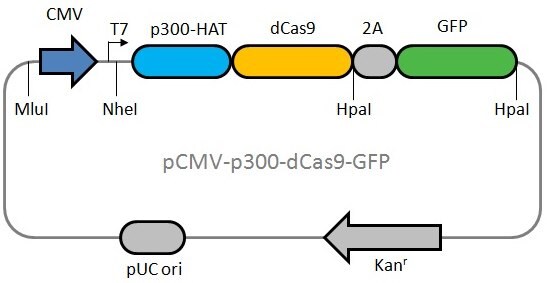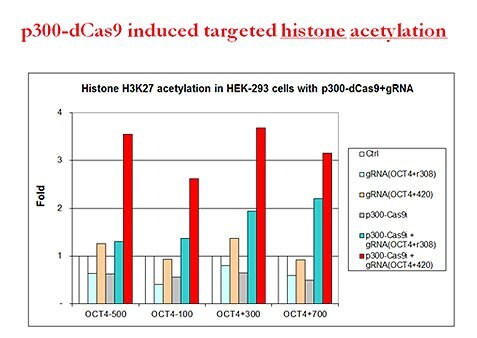CRISPR-based Gene Activation
CRISPR for Epigenetic Editing – dCas9
Epigenome editing is a tool in which the DNA or histone is modified at specific sites in the genome using engineered molecules. This strategy requires precise targeting which is accomplished through the use of nuclease-deficient Cas9 (dCas9). However, unlike genome editing, epigenome editing does not affect genome DNA sequence.
p300-dCas9 Induced Targeted Histone Acetylation
Histone acetylation, carried out by histone acetyltransferases (HATs), plays a fundamental role in regulating chromatin dynamics and transcriptional regulation. The importance of histone acetylation in cancer has been clinically validated with several inhibitors of HDACs as anti-tumor agents. p300/CBP is a histone acetyltransferase (HAT) whose function is critical for regulating gene expression in mammalian cells. The p300 HAT domain (1284-1673) is catalytically active and can be fused to nucleases for targeted epigenome editing.
We have developed an approach for efficient targeted histone acetylation using CRISPR. We demonstrated that gRNA can successfully direct dCas9 fused to p300 HAT catalytic domain to increase levels of histone acetylation and endogenous gene expression. This strategy for investigating functions of histone acetylation at specific genomic loci has enormous potential for research and therapeutic applications.
dCas9-p300 CRISPR Gene Activator
The dCas9-p300 CRISPR Gene Activator system is based on a fusion of dCas9 to the catalytic histone acetyltransferase (HAT) core domain of the human E1A-associated protein p300. This approach has been independently validated by the Gersbach lab (Duke University) to activate genes at both proximal and distal locations relative the transcriptional start site (TSS). The dCas9-p300 histone acetylation approach represents a distinct mechanism of action relative to dCas9-VP64 or other similar gene activation motifs. While activation domains, such as VP64, help recruit transcription complexes to the promoter region, they are at the mercy of the epigenetic state of the gene and dependent on the availability of additional transcriptional proteins. Conversely, the p300 histone acetyltransferase protein opens a transcriptional highway by releasing the DNA from its heterochromatin state and allowing for continued and robust gene expression by the endogenous cellular machinery.

Above is a map for the plasmid which expresses the dCas9p300 fusion protein. This plasmid also co-expresses GFP from the same transcript as dCas9p300 to easily monitor delivery and expression in your target cell type. The dCas9p300 plasmid can be co-transfected with custom-made U6-gRNA plasmids to target activation near transcription start sites or other regulatory locations. An Oct4 control plasmid is available (CRISPR17-1EA) which can be used to help establish the dCas9p300 approach in your laboratory. This Oct4 control has been shown to work in HEK293 cells (Figure below). We recommend testing the Oct4 control in HEK293 cells alongside any new cell type you wish to try.

OCT4 (POU5F1) is one of the most difficult targets to be activated
Octamer-binding TF 4 (Oct4, POU5F1) is the key transcription factor (TF) that maintains pluripotency of stem cells. It also plays a critical role in reinstating cellular pluripotency. The expression of OCT4 is stringently silenced in differentiated cells. Activation of silenced OCT4 gene has become a hallmark event during epigenetic reprogramming into induced pluripotent stem cells (iPSCs).
p300-dCas9 activated endogenous OCT4
p300 HAT domain (1284-1673) was fused to dCas9 (D10A, H840A) to generate p300-dCas9. Nine gRNAs were designed to target OCT4. Six of the nine gRNAs tested, along with p300‑dCas9, resulted in 2-fold or higher OCT4 transcript levels compared to control HEK293 cells.
References
Para seguir leyendo, inicie sesión o cree una cuenta.
¿No tiene una cuenta?